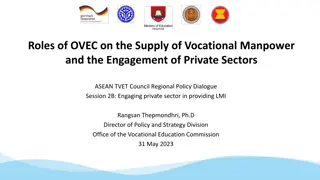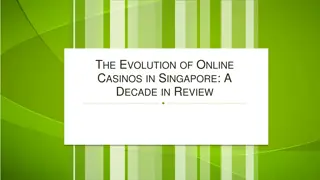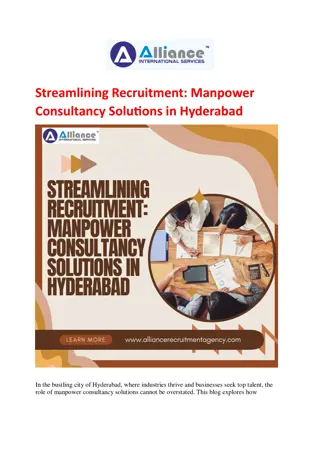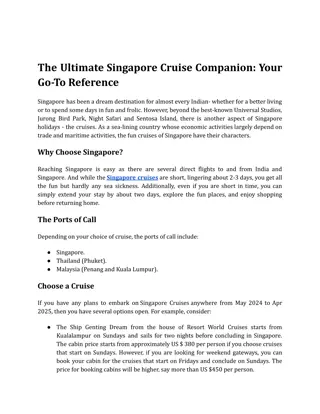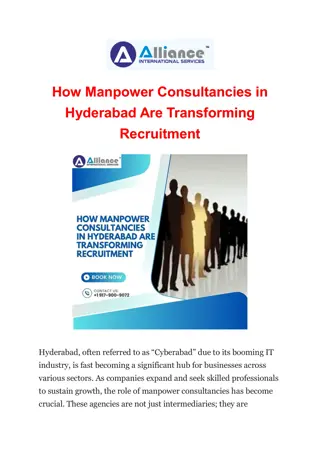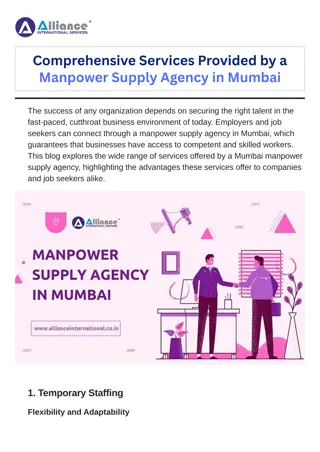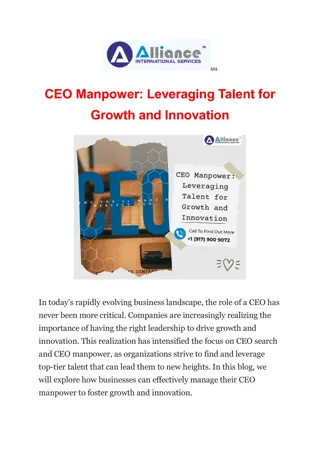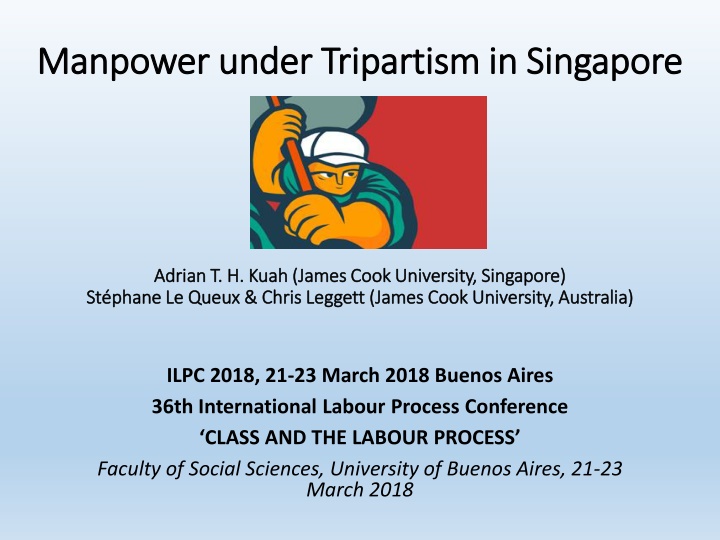
Manpower and Tripartism in Singapore
Explore the dynamics of labor deployment, tripartism, and manpower strategies in Singapore, focusing on the balance between economic growth, productivity, and social integration. Learn about the historical evolution of labor relations through paternalist corporatism and the challenges posed by incorporating migrant workers into the workforce.
Download Presentation

Please find below an Image/Link to download the presentation.
The content on the website is provided AS IS for your information and personal use only. It may not be sold, licensed, or shared on other websites without obtaining consent from the author. If you encounter any issues during the download, it is possible that the publisher has removed the file from their server.
You are allowed to download the files provided on this website for personal or commercial use, subject to the condition that they are used lawfully. All files are the property of their respective owners.
The content on the website is provided AS IS for your information and personal use only. It may not be sold, licensed, or shared on other websites without obtaining consent from the author.
E N D
Presentation Transcript
Manpower under Manpower under Tripartism Tripartism in Singapore in Singapore T. H. . Kuah Kuah(James Cook University, Singapore) (James Cook University, Singapore) St phane Le Queux & St phane Le Queux & Chris Leggett Chris Leggett (James Cook Adrian Adrian T. H (James Cook University University, , Australia Australia) ) ILPC 2018, 21-23 March 2018 Buenos Aires 36th International Labour Process Conference CLASS AND THE LABOUR PROCESS Faculty of Social Sciences, University of Buenos Aires, 21-23 March 2018
In a nutshell (1) In a nutshell (1) In the absence of natural resources, the deployment of labour has been central to the success of Singapore (Kuah, Le Queux and Hassan, 2017). Singapore is a place where labour has been put at the center of a productivist agenda to support economic growth, perhaps at the expense of productivity. Shifting institutional support to Human Resource Development, directed at the Singaporean core workforce, to try buckle the trend.
In a nutshell (2) In a nutshell (2) There is indeed a socio-demographic component underlying this imperative. Social pressures are mounting over the dramatic increase in the ratio of migrant workers to Singaporean workers. Hence the need and challenge to incorporate migrants (Leggett and Le Queux, 2014) Tightening labour market is perceived as a means to persuade employers to extract the best from their human resources, and reduce their dependence on foreign skilled manpower.
The beginning: The beginning: Paternalist Corporatism Paternalist Corporatism The National Trade Union Congress (NTUC) formed by the ruling political party (the People s Action Party, or PAP) in 1964 that provided the government the thrust to propel its industrial relations initiatives. Singapore National Employer s Federation (SNEF) incorporated in 1980. The Ministry of Labour renamed the Ministry of Manpower (MOM) in 1998: a key government agency for labour and employment issues.
Paternalist Corporatism Paternalist Corporatism Symbiotic officials in public service are regularly seconded into the NTUC to boost the quality and standing of the NTUC leadership. Abled union leaders are also co-opted into the PAP leadership, fielded as Member of Paliament (MP) and appointed to key offices of Government-Linked Companies (GLC). Key PAP MPs have been made to work in the unions to get to know union leaders and members, and their problems (Leggett et al., 2017) PAP NTUC relationship means senior
Manpower under Manpower under Ultra Ultra- -Corporatism: a shared destiny Corporatism: a shared destiny There can be few other places in the world where the social regulation of the labour market has been so consistently and explicitly a central component of national development strategy as it has been in Singapore (Coe and Kelly, 2000: 414). From 1979, the government strategically induced a shift in Singapore s economy towards high technology, high value- added production which required a parallel shift in the management and development of the labour market. For Singaporean workers the shift meant upgrading their skills, both in technical proficiency and in the cultivation of right attitudes . The regulatory means for skills formation and character building were government agencies, the NTUC and the SNEF. Workforce development increasingly became a tripartite endeavour.
The Productivity Movement: The Productivity Movement: backbone of industrial governance four decades on backbone of industrial governance four decades on Source: Ohno and Kitaw (2011)
The Productivity Movement The Productivity Movement: : recent recent initiatives initiatives An Inter-Agency Productivity Taskforce formed in 2009 formally proposed initiatives that included Skills Future under the Workforce Development Agency (WDA), led by the SNEF. The Tripartite Alliance for Fair and Progressive Employment Practices (TAFEP) was set up to promote the wider adoption of fair and progressive employment practices among employers.
The Productivity Movement The Productivity Movement: : recent recent initiatives initiatives Next, a tripartite National Productivity and Continuing Education Council was established to boost skills and enterprise productivity, and develop a comprehensive system for CE and training. Concurrently, a raft of policy measures was introduced to improve Singapore s productivity output (e.g. providing tax exemptions and incentives for companies to innovate and embrace technology; establishing funding mechanisms for the Singaporean workforce to constantly upgrade their skill).
Singapore is increasingly dependent on a migrant workforce: has doubled from 2000 to 2015 to reach 38.5% of total active population. Source: World Bank Group https://data.worldbank.org/indicator/SP.POP.TOTL?locations=SG&view=chart
International Migrant Stock: The estimates are derived from the data on foreign-born population-- people who have residence in one country but were born in another country. When data on the foreign-born population are not available, data on foreign population--that is, people who are citizens of a country other than the country in which they reside--are used as estimates. 2.544m 2.165m 1.711m 1.352m 0.991m 0.519m Source: World Bank Group https://data.worldbank.org/indicator/SP.POP.TOTL?locations=SG&view=chart
Breakdown of Breakdown of Foreign Workers in Foreign Workers in Singapore Singapore 1,600,000 1,400,000 1,200,000 1,000,000 800,000 600,000 400,000 200,000 - Jan-07 Jan-08 Jan-09 Jan-10 Jan-11 Jan-12 Jan-13 Jan-14 Jan-15 Jan-16 WP (Foreign Domestic Worker) WP (Construction) WP estimated (Manufacturing) WP estimated (Health & Social Services) WP estimated (Marine, Process and others) Employment Pass S Pass Work Permit (Total) Total Foreign Workforce See also: Foreign workforce numbers http://www.mom.gov.sg/documents-and-publications/foreign-workforce-numbers
A Dual (Flexible) A Dual (Flexible) Labour Labour Market Market The direction for labour market flexibility is from the tripartite National Wages Council (NWC). The explicit ongoing mission of the NWC is to ensure that real wages are in line with productivity growth, not ahead of it. The occupational structure of foreign workers in Singapore is segmented according to a hierarchy of work passes that mainly differentiate levels of skill. In the semi- and unskilled categories, employment appears to be in an analytically distinct secondary labour market.
Discussion Discussion The new agenda presents some challenges: First, authorities want to reassure FDIs that they will not be restricted from access to the skilled HR they need. Yet, in spite of upskilling, a critical issue is whether or not the Singaporean core workforce, and especially its young graduates, are competitive with global talents. Second, in a dual labour market, a challenge is how to manage the only partially incorporated migrant workers for social cohesion and industrial order.
Discussion Discussion Third, to better manage the partial incorporation of migrants. NWC lifting minimum wage in some sectors dominated by migrant labour. The NTUC and the SNEF have established a Migrant Workers' Centre to facilitate the training of migrant workers and educating them about fair employment practices. Some NTUC affiliates began to recruit foreign workers into their memberships.
Discussion Discussion Yet, there are rising resentment over overcrowding and ghettoization. MOM is also concerned about foreign sources of disruption to harmonious industrial relations. And now there are even policy initiatives primarily targeting the Singaporean core !!! When we look at the migrant workers issue, we are not looking at it from the perspective of human rights. We are looking at it on a need basis... Like it or not, we need to sustain and grow an economy that is able to generate an annual per capita [GDP] of US$35,000. At the end of the day, whatever factors would be able to help us to sustain the growth of the economy for the benefit of our countrymen, for the benefit of our country; we will definitely go for it (Yeo Guat Kwang, NTUC leadership: BBC, 2010).
Conclusion Conclusion Corporatist system, when government and social actors collude, can deliver a high level of economic productivity outcomes. Policy diffusion in Singapore happens rapidly because of closely knitted relationships between the tripartite actors. This institutional machinery is obviously working and policies cascade down efficiently. Yet, we do not see evidence in productivity growth. Evidence suggests that labour influx has provided the input for economic growth. Singapore government is now aware that the volume of labour and associated migration become a social dilemma. Hence, productivity & skills formation agenda is getting even more central to governance, rather than sole reliance on foreign labour.
References Coe, N. M., and P. F. Kelly (2000) Distance and Disclosure in the Local Labour Market: the Case of Singapore , Area, vol. 32, n 4, p. 413-422. Kuah, A.T.H., S. Le Queux and S. Hassan (2017) Singapour : L ultra-corporatisme au service Singaporean Core , in Delahaie N. & Le Queux (eds.) Regards crois s sur les relations professionnelles en Asie du Sud-Est. Chronique Internationale de l'IRES, num ro sp cial, No 156, p. 60-74. Leggett, C., A.T.H. Kuah and B. Gan (2017) Employers Associations in Singapore: Tripartite Engagement , in Benson J., Zhu Y., Gospel H. (eds.), Employers Associations in Asia: Strategy and Structure, London, Routledge. Leggett, C., and S. Le Queux (2014) Unions as Agency of Migrant Workers Discrimination and Social Exclusion .New Frontiers for Citizenship at Work, CRIMT International Conference, Montr al, 12-14 May. Ohno, I., and D. Kitaw (2011) Productivity Movement in Singapore . JICA/GRIPS, Handbook of National Movements for Quality and Productivity Improvement (Kaizen), p. 49-68. Contact: adrian.kuah@jcu.edu.au stephane.lequeux@jcu.edu.au



